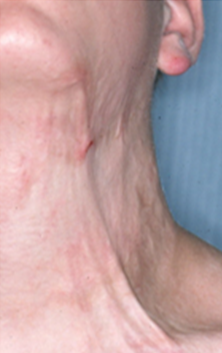Common Scar Problems
We encounter a range of problems with scars. A number of the more common ones are detailed below.
A severe hypertrophic scar
‘Angry’, inflamed or hypertrophic scars
‘Angry’ scars are those which become red, itchy, irritated, firm and hard. The commonest form of this scar is the hypertrophic scar seen after burn injury. However, even seemingly normal scars can have areas which become active, sometimes for no clear reason. There are a number of treatments for this type of scar ranging for topical silicone to laser therapy.
A keloid scar
Keloid scars
Keloid scars are angry scars that grow outside the area of original injury. They are more common in certain ethnic groups and grow incessantly. Traditionally, they have been very hard to treat as there is a high tendency to recur. We have a variety of options for this type of scarring ranging from the traditional pressure therapy to state-of-the-art Cryoshape™.
A stretched scar
Acne scars, stretch marks and other ‘atrophic’ scars
These type of scars are all associated with a degree of ‘underhealing’. For stretched scars, the skin had an insufficient strength during healing and as a result, visibly widened the final scar. In stretch marks, the skin has been weakened by the expansion of pregnancy and this damages the strength of the bottom layer of the skin without the presence of a wound. Acne scars come in a variety of forms depending on their appearance. As well as being slightly depressed from the surrounding skin, they may be stuck to underlying tissues. The treatment for the atrophic group is entirely dependent on the degree of scarring. New approaches include fat filling from below and needling to remodel the skin.
A scar contracture of the left side of the neck
Scar Contractures
Scar contractures occur when a tight, fibrous band of scar develops within the skin. It usually occurs along a line of tension. The treatment is usually surgical but caught early, it may be possible to avoid surgery with a carefully monitored routine of splinting and scar management.
Itchy scars
It is normal for scars to get slightly itchy as they heal. However, if a scar is too itchy, it may become intensely irritating, cause you to scratch and inflame the area or disturb your sleep. There may be simple solutions like applying cold emollient cream or antihistamine preparations. However, severely itchy scars may warrant new approaches such as stronger anti-itch medications or botulinum toxin injections into the scar.
Painful scars
Painful scars are unusual. A scar that is painful may be a sign of inflammation. This may improve with conventional treatments such as massage and moisturisation to desensitise the area. However, other approaches may be required dependent upon the problem including scar revision or resurfacing for pain due to scar contractures.
Treatment
The type of treatment required will depend upon the type of scar, its stage of healing and a number of other factors in your history such as prior treatments, other medical conditions and allergies.
Research
The Scar Team based at The Bristol Nuffield Hospital are passionate about research into the field of wound healing and scarring. We are keen to understand why angry scars develop
Support
As a patient with a significant scar, it can be difficult to know where to turn to for support in all its forms, from financial to patient groups.
Prevention
There is no guarantee that any one measure will prevent a scar from forming. This is despite some quite impressive claims made by the manufacturers of certain cosmetic products.





